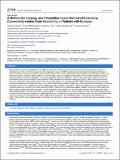A Multimodal Imaging- and Stimulation-based Method of Evaluating Connectivity-related Brain Excitability in Patients with Epilepsy
Author(s)
Shafi, Mouhsin M.; Whitfield-Gabrieli, Susan; Chu, Catherine J.; Pascual-Leone, Alvaro; Chang, Bernard S.
DownloadShafi-2016-A Multimodal Imaging- and Stimulati.pdf (1.820Mb)
PUBLISHER_POLICY
Publisher Policy
Article is made available in accordance with the publisher's policy and may be subject to US copyright law. Please refer to the publisher's site for terms of use.
Terms of use
Metadata
Show full item recordAbstract
Resting-state functional connectivity MRI (rs-fcMRI) is a technique that identifies connectivity between different brain regions based on correlations over time in the blood-oxygenation level dependent signal. rs-fcMRI has been applied extensively to identify abnormalities in brain connectivity in different neurologic and psychiatric diseases. However, the relationship among rs-fcMRI connectivity abnormalities, brain electrophysiology and disease state is unknown, in part because the causal significance of alterations in functional connectivity in disease pathophysiology has not been established. Transcranial Magnetic Stimulation (TMS) is a technique that uses electromagnetic induction to noninvasively produce focal changes in cortical activity. When combined with electroencephalography (EEG), TMS can be used to assess the brain's response to external perturbations. Here we provide a protocol for combining rs-fcMRI, TMS and EEG to assess the physiologic significance of alterations in functional connectivity in patients with neuropsychiatric disease. We provide representative results from a previously published study in which rs-fcMRI was used to identify regions with abnormal connectivity in patients with epilepsy due to a malformation of cortical development, periventricular nodular heterotopia (PNH). Stimulation in patients with epilepsy resulted in abnormal TMS-evoked EEG activity relative to stimulation of the same sites in matched healthy control patients, with an abnormal increase in the late component of the TMS-evoked potential, consistent with cortical hyperexcitability. This abnormality was specific to regions with abnormal resting-state functional connectivity. Electrical source analysis in a subject with previously recorded seizures demonstrated that the origin of the abnormal TMS-evoked activity co-localized with the seizure-onset zone, suggesting the presence of an epileptogenic circuit. These results demonstrate how rs-fcMRI, TMS and EEG can be utilized together to identify and understand the physiological significance of abnormal brain connectivity in human diseases.
Date issued
2016-12Department
McGovern Institute for Brain Research at MITJournal
Journal of Visualized Experiments
Publisher
MyJoVE Corporation
Citation
Shafi, Mouhsin M. et al. “A Multimodal Imaging- and Stimulation-Based Method of Evaluating Connectivity-Related Brain Excitability in Patients with Epilepsy.” Journal of Visualized Experiments 117 (2016): n. pag. © 2016 Journal of Visualized Experiments
Version: Final published version
ISSN
1940-087X